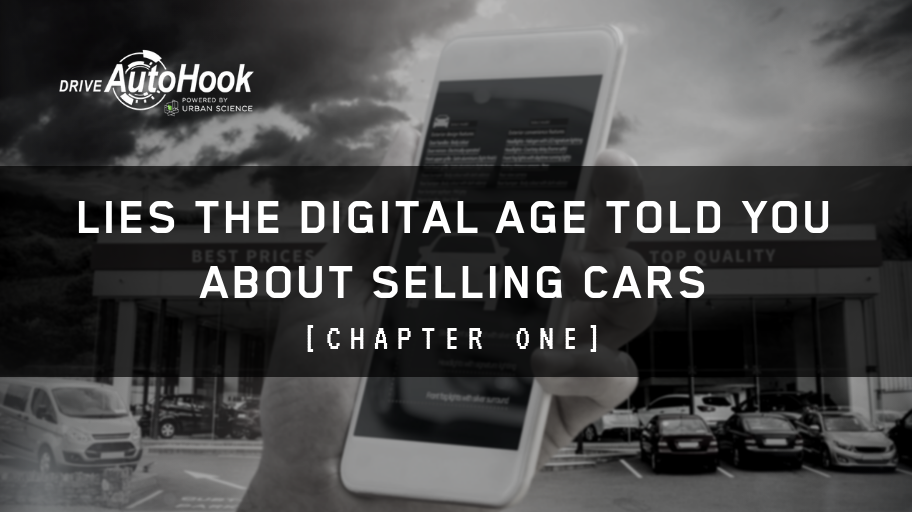| by David Metter, President of AutoHook powered by Urban Science
In Part I of Lies the Digital Age Told You About Selling Cars, we overturned one of the most blindly accepted industry-wide standards about the current state of consumer car buying behavior. For far too long, the assumption has been vehicle shoppers have everything they need to make a purchase decision online, and they already know what they’re buying before ever stepping foot in a showroom. The common misconception has been that the average consumer in the digital age only visits one dealership before purchasing a vehicle.
What we found after surveying 2,748 U.S. consumers that have purchased a car in the last year is that the above statement couldn’t be further from the truth. In reality, not only does the average customer visit at least 2.4 dealerships before making a buying decision, but almost half – 46% – said they visited three or more dealers before purchasing. Over a quarter of our sample size, 26%, said they visited four or more dealerships before buying. All of this data was collected by AutoHook and Urban Science in May of 2018 from people who purchased or leased a vehicle within the last year – not from a published study conducted five years ago.
As a former general manager of a dealership, CMO of a privately-held dealer group and as a marketer in general, I found the fact that roughly 1 in 4 people (26%) in the year 2018 visit four or more dealerships before buying a car to be personally absurd. Though surprising, this statistic solidified a new truth about the state of our industry. Contrary to what dealers have been told, the in-store experience is arguably more important in the digital age than ever before in the history of the car business – and for several reasons.
The most prominent reason being if a customer has a bad experience with one of your salespeople when they come in for a test drive, they will leave and buy from someone else. If they go to two dealerships and have a bad experience at both, they will go to a third and even a fourth dealer to buy from the one that provides them with the experience they expect and deserve.
Just like everything else that has surfaced from the digital age, car shoppers have a LOT of choices when it comes to what they’re going to buy and who they’re going to buy from. Purchase decisions are still made at physical dealerships, most likely following a test drive – NOT exclusively online. Shoppers in-market for a new vehicle don’t have their minds made up about what they’re going to buy by the time they visit their first dealership. Outsell says 6 out of 10 car shoppers enter the market unsure of what they want to buy. Our own research and survey data consistently shows 78% of people are still considering multiple brands by the time they visit their first dealership.
So we as an industry, we HAVE to get this right. Instead of operating based on pure, often biased assumption, dealers need to seriously reconsider their order of priorities in terms of how they run their business and where they spend their money. The digital age has armed us with so much intellectual power, yet at the same time, it’s made us a little lazy. It’s cast a shadow over what’s really important – defining value and personal worth by likes, clicks and follows rather than interpersonal relationship skills.
Part II of Lies the Digital Age Told You About Selling Cars verified the auto industry has become too quick to rely on technology as a crutch to do the work for us, rather than picking up the phone and having a conversation - or dare I suggest having the inventory knowledge and social skills to not only sell a car, but to foster ongoing relationships that lead to repeat, loyal customers. It is officially time for a new dialogue to emerge. The question we as an industry need to be asking is not how can we leverage new technologies to help us sell cars, but how can we leverage new technologies to help our salespeople sell cars?
Rather than answering the above question based on my expertise and years of experience in this business, I’ll share the real-life success stories of how two actual dealerships in the digital age are using great data processed through great technology to help their people sell more cars and lose fewer opportunities.
DEALERSHIP #1
One of our dealer clients needed an accurate way to measure the true effectiveness of their follow-up process by knowing what was and wasn’t working within their current lead mix as well as how many opportunities their salespeople sold compared to how many they lost to competitors. Using their individual salesperson data, we analyzed each person’s sales and defections and identified who had the most potential to improve. We then pinpointed the time frame during their follow-up process when their people struggled the most, which for this particular store was during days 0-4 after a lead hit their CRM. Lastly, we exposed their highest defecting lead source.
Armed with a roadmap highlighting their greatest areas of opportunity, the owner of this dealership shared this data with his sales staff and reviewed each person’s sales and defection trends with them one-on-one every month. He created an environment of transparency and friendly competition by making this defection analysis technology available to all his salespeople, thus holding them personally accountable for every sale they lost in addition to what they closed.
The dealer then helped his staff implement a more aggressive follow-up strategy for working leads 0-4 days old. He provided additional training on how to better work leads that came from their highest defecting source (especially during this time frame). He took the time to listen to feedback from all his salespeople and found opportunities for peer coaching to help further reduce their collective number of defections. He also implemented a system to reward the people who showed improvement each month.
With a refined follow-up strategy fueled by better prepared, more empowered salespeople, they saw the following results in just 90 days:
Their overall defections decreased by 89%, with a 44% decrease in defections specifically during days 0-4 post-lead.
They increased their number of closed sales tied to their highest defecting lead source by an astounding 242%.
Most importantly, when it came to the salesperson identified as having the highest defection rate, that individual successfully increased their closed sales by 78% and went from being the worst performer on the team to one of their top performers.
DEALERSHIP #2
This store needed a way to identify any potential problems with their lead mix to see which sources were underperforming and why. Using the same defection analysis technology as Dealer #1, they were able to determine the issues they were having with their highest defecting lead source were due to external factors outside of their control – rather than a lack of effective internal follow-up. They then confidently decided to cancel this lead provider and put those marketing dollars back towards their bottom line.
Ninety days later, they saw a 61% average increase in salesperson performance after removing that lead source – not to mention they were able to free up a total of 40 man-hours per week that were previously devoted to working those high-defecting leads. The best result of all? Four of their salespeople went from being average or below average performers to their TOP FOUR salespeople.
And they didn’t stop there. This dealer applied the same technology to define which model(s) in their inventory represented the most defections specific to their salespeople so they could go after leads tied to underperforming models more aggressively. Model A represented the most opportunity for improvement, and again within 90 days, they increased closed sales specific to Model A by 51% and reduced defections by 30%.
What we can conclude from the examples listed above, is that technology can help your people in a multitude of ways. Technology can help your salespeople close more deals and reduce their defection rates. Technology can help your people free up wasted time chasing leads from a faulty source. Technology can identify which models your people struggle with the most in order to boost specific model performance. Technology can even tell you if your customers are leaving your store to buy the same model somewhere else, or if they’re defecting to another brand entirely.
But the most important thing to take away is that technology in the digital age still doesn’t sell cars. It can do a lot to light up the right track for your people to do just that, but at the end of the day your salespeople need to know your inventory like the back of their hand – what makes it better than competing brands or models, and what makes doing business with you a better option than anywhere else.
The truth in a current landscape littered with lies is that there’s no way for any one dealer to know everything they need to know about their overall market, which models represent the most opportunity for their store, and if their salespeople are doing their jobs and following up with leads appropriately. That’s where the technology and data come into play. With a complete view of who is struggling and exactly what they’re struggling with during the initial contact and follow-up process, dealers can take immediate action to help their salespeople reduce defections and improve their performance across all facets of their sales operations – so they can be one of the 2.4 dealerships (at least) with a shot of winning the sale.



























